How Israel nearly failed to spot Syria’s nuclear reactor, from the man who found it
“Dr. Abdul Qadeer Khan was the seed of calamity. Wherever he went around the globe, you needed to be sniffing around.” So began Dr. Amnon Sofrin, the head of the Mossad’s intelligence division in the mid-2000s, as he retold the story of Israel’s discovery that Syria had secretly built a nuclear reactor and was close to bringing it online.
Some 15 years after the destruction of the reactor in Deir Ezzor, Sofrin revealed in an interview with Zman Israel, the Times of Israel’s sister site, how Israel came to carry out the strike, as well as how close it came to committing one of its biggest intelligence blunders.
Sofrin, who began his career in Military Intelligence and then after his discharge joined the Mossad spy agency, described, step by step, the tortuous developments ahead of a decisive conversation he had with then-prime minister Ehud Olmert, during which the Israeli premier was informed that within a few weeks Syria was set to become a nuclear-capable nation.
First warning sign: The Libyan surprise
“In December 2003, the British and Americans announced that after several months of negotiations, they managed to convince [Libyan leader Muammar] Gaddafi to give up his plans for nuclear weapons — in exchange for lifting sanctions,” Sofrin said.
“I look at this incident and ask myself: Did we know about it? I understood that there was some kind of infrastructure in Libya, but we were very far from understanding the situation and how close Gaddafi was to a nuclear [weapon]. We all understood that Israel was excluded from the process and this required us to draw immediate conclusions,” he said.
Screen capture from video of Amnon Sofrin, former head of the Mossad’s intelligence division. (YouTube. Used in accordance with Clause 27a of the Copyright Law
It turned out that the Libyan nuclear project was at a very advanced stage. The person behind the project was Khan, a Pakistani physicist who sold his nuclear know-how to anyone who wanted it. At least two countries were known to have bought Khan’s services — Iran and Libya.
Behind the concealment of the Libyan project was the Swiss Tinner family, which supplied the construction materials to centrifuge enrichment sites using forged bills of lading presented to Swiss authorities.
The two main nuclear sites in Libya were hidden in a school and a rural farm. At some point, information about the Tinner family’s involvement reached the CIA, making them, effectively, double agents providing information on the progress of the Libyan nuclear project overseen by Khan.
This was the intelligence upon which the US and Britain relied when they approached Gaddafi and threatened to attack the facilities. Gaddafi did a quick calculation and realized that his fate would be the same as Saddam Hussein’s in Iraq, and he agreed to reveal the entire project and allow UN inspectors to dismantle it.
Israel, which was excluded at all stages — from the intelligence to the secret negotiations — was shocked.
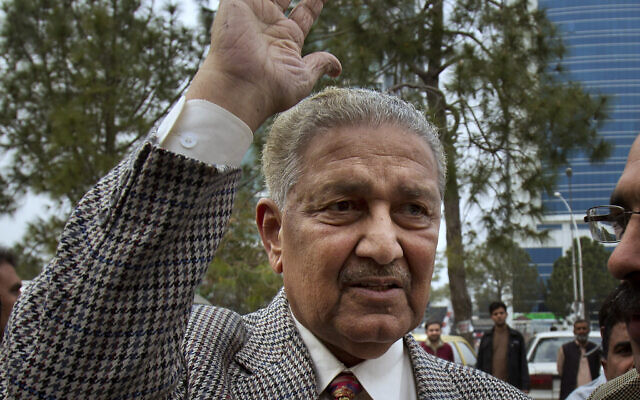
In this Feb. 26, 2013, file photo, Pakistan’s nuclear scientist Abdul Qadeer Khan waves to supporters in Islamabad, Pakistan (BK Bangash/AP)
The traveling scientist and a suspicious trail
“With the American announcement, we realized that the Pakistanis were heavily involved in Libya,” Sofrin said. “We started researching and the name of Dr. Khan immediately came up, the father of Pakistan’s first Muslim bomb.
Three countries jump out at me: Egypt, Saudi Arabia, and Syria. I immediately dismiss the first two, because of their dependence on and fear of the US
“We understood that he came to Libya with his people for a turnkey project. He distributed centrifuges and facilities throughout Libya. I looked at the data and said to myself, ‘Wait, wait. If Dr. Khan is the project manager, let’s see where else he has been in the Middle East.’
“After a very quick check, three countries jump out at me: Egypt, Saudi Arabia, and Syria. I immediately dismiss the first two, because of their dependence on and fear of the US. I assessed at the time that they would not make such a blatant and defiant move against the US,” Sofrin said.
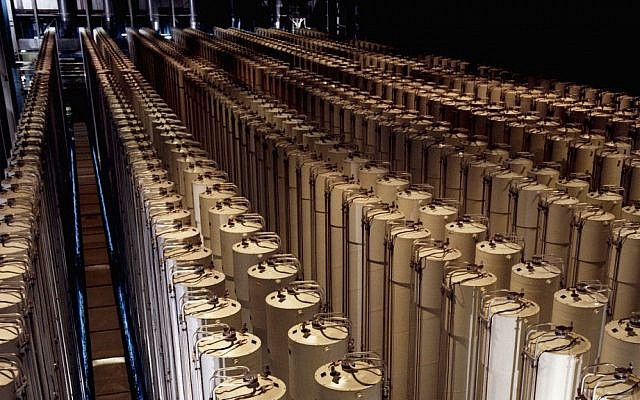
Illustrative. Centrifuges enriching uranium. (Public Domain/US Department of Energy/Wikimedia Commons)
In the early 2000s certain information had reached Israel from a third party about Syrian activities related to nuclear centrifuges. The information was raw and initial and did not develop to the point of being enough to launch an intelligence operation.
This was until the American-British announcement about the dismantling of Gaddafi’s project.
“Regarding Syria, I immediately had a concern,” Sofrin said, “It cohered with the raw information circulating in the system. I told my people, ‘Let’s see what’s going on. Is there something here that we didn’t recognize before as a suspicious sign?’ I took two of my researchers — veteran and experienced — and asked them to take all the material from the last decade and analyze Syria’s intentions in the context of the Libyan case.
“My idea was to focus on the relationship with the Pakistanis and whether there is anything in the intelligence that could point to a nuclear project. After a month and a half of work, they come back to me with a clear conclusion that Syria has a nuclear program. Regarding the details, they could not explain exactly what, how, or why, but the conclusion was decisive: There is activity that means [the Syrians are] building nuclear capabilities, and this is already happening in January 2004.”
At that stage, as far as the Mossad was concerned, there was already a suspicious convergence of circumstances, although the conclusions were not unequivocal.
“There were too many question marks in this puzzle,” recalled Sofrin.
The IDF’s Military Intelligence Directorate continued to investigate the matter, but the bulk of the collection and analysis was done by the Mossad.
In February 2004, the Mossad issued a first warning about the possibility of a nuclear project in Syria
“I asked to see the 150 key pieces of intelligence on which my Mossad researchers based their conclusion. I wanted to read them alone, quietly, to see if I came to a different conclusion. At the same time, I built a ‘red team’ that would try to challenge the final conclusion regarding the Syrian nuclear project.
“I emphasized that the red team would not know the conclusion of the two researchers. In this case, we acted in relative separation so as to be as precise as possible in our determination. We all came to the same conclusion, that there is something there that cannot be explained or defined at this stage, but something is happening,” he said.
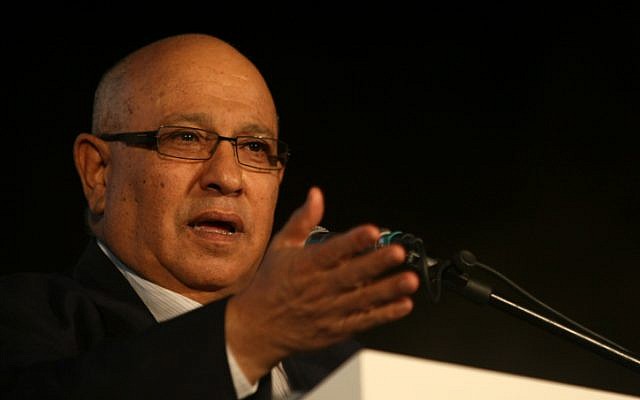
Former Mossad chief Meir Dagan (Kobi Gideon/Flash90, File)
In February 2004, the Mossad issued a first warning about the possibility of a nuclear project in Syria. According to Sofrin, the Mossad document “clearly pointed” to suspicious activity based on the Libyan experience and the involvement of the Pakistani scientist.
However, the focus was still on the search for enrichment sites and supply routes, and traces of centrifuge parts. Khan specialized in this method of enrichment and the working assumption was that Syria was following the same path, an assessment that later proved to be wrong.
Immediately after the conclusions of the Military Intelligence teams, Sofrin updated the head of the Mossad. “I went up to Meir Dagan with this and laid out the whole picture in front of him. He and Tamir Pardo, who was his deputy, decided to prepare a plan of activities to reveal what was happening there,” he said.
“It was a very orderly work plan by the Mossad, with many operations along the way. What happened intelligence-wise afterward was similar to opening windows — each time another window opened for us with a new tip. At the end of 2006, we began to form up around the understanding that there are several places with suspicious activity. At this point, we could not define what is in each place, but we assessed that there was nuclear activity,” he said.
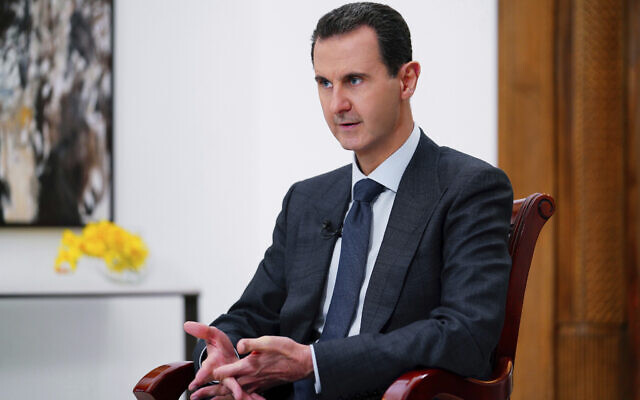
Syrian President Bashar Assad in Damascus, Syria, 2019. (SANA FILE via AP, File)
At that stage, both Military Intelligence and the Mossad were deep in a global intelligence operation to understand Syrian President Bashar Assad’s intentions. Meetings of the two organizations to discuss the situation had multiplied and become more and more frequent.
The incoming head of the National Security Agency at the time, Major General Amos Yadlin, told a conference of the Institute for National Security Studies that his first conversation in his new role was with the head of the research division, Brigadier General Itai Baron.
“I told him that the most important thing for me was to discover the nuclear reactor that Israel doesn’t know about,” he told the conference.
The statement by Yadlin raised eyebrows in the security establishment in light of the advanced stage at which the Mossad was and the unequivocal warning issued in January 2004.
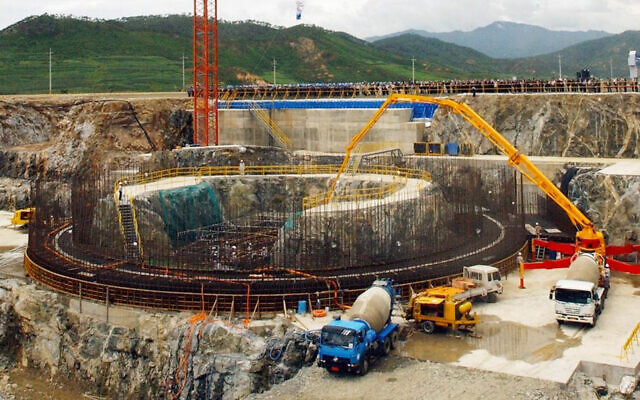
Work on construction for the foundation of a reactor underway at Kumho on North Korea’s northeastern coast, August 7, 2002. (Ahn Young-joon/AP)
“Slowly, slowly we were increasing our activity and completing more and more pieces in a huge puzzle, but we still didn’t have the smoking gun,” said Sofrin.
A turning point came during one of the periodic discussions on the matter with Military Intelligence, he said.
“A young major told me: ‘Maybe we are going astray’ in the key assumption “we had regarding centrifuges and the right direction is actually a plutonium reactor.’”
Enrichment in a plutonium reactor is accomplished by fissioning metal rods inserted into the reactor core. For this purpose, the construction of a reactor with a lead and concrete cover around it is required to prevent leakage. Also, unlike uranium enrichment centrifuges that can be deployed at any location, a plutogenic reactor is usually built near a water source to allow its continuous cooling.
Another common step to the bomb is through the use of centrifuges that enrich uranium to the level of 90 percent, from which the nuclear explosive material is extracted. The naturally mined uranium is turned into a gas, put into centrifuges and enriched by spinning them. After it is enriched to 90%, the uranium is turned into a metallic substance — the heart of the bomb.
Taking a new approach
“This comment by a Military Intelligence representative in 2006 led us to rethink the context of intelligence coverage. We asked, ‘What should we look for?’ Because if it was a plutogenic reactor — it did not correspond to Pakistani knowledge, but rather to the knowledge of North Korea,” Sofrin said.
“Then, shortly afterward, we discovered increasing activity of North Koreans in Syria. We became aware of this activity as part of Pyongyang’s assistance in setting up production lines for Syria’s Scud D missiles. Then we realized that there were more Koreans.”
A hint at the kind of intelligence that Israel may have exploited came in an interview given by Brigadier General (reserve) Eli Ben-Meir, who in 2006 was head of the technical division in the Military Intelligence Directorate. He was once asked in an interview with Radio 103FM if reports of an increased number of Koreans arriving at Syrian hospitals with stomach disorders contributed to setting off warning lights of a possible plutonium reactor. Ben-Meir did not deny the suggestion.
The Mossad was putting together more pieces that strengthened the assessment that what they were looking for was most likely a plutogenic reactor. But the smoking gun was still missing. It was clear to everyone that it was a race against time — until March 2007 and an alleged Mossad coup in Vienna.
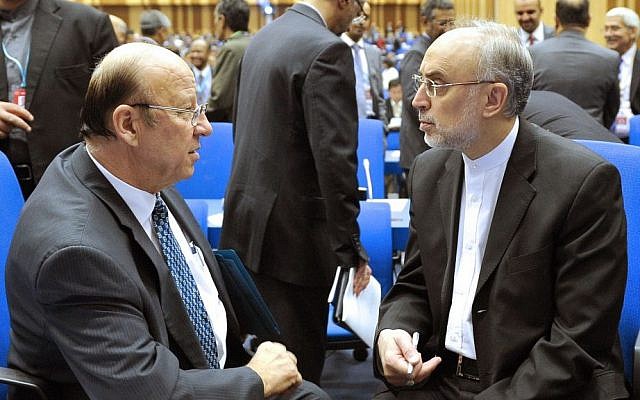
Syrian attaché Ibrahim Othman, left, talks to the head of Iran’s Atomic Energy Organization, Ali Akbar Salehi, prior to the start of the general conference of the International Atomic Energy Agency, in Vienna, Austria, September 16, 2013. (Hans Punz/AP)
According to an investigation by The New Yorker — which was never denied by Israel — Mossad agents followed Ibrahim Othman, the head of Syria’s Atomic Energy Agency, who arrived to attend the annual meeting of governors at the UN Atomic Energy Agency headquarters in Vienna. According to the investigation, Mossad staff broke into his hotel room, cloned his PC, and left without a trace.
We saw many suspicious signs: it was an isolated area, near the Euphrates River; the construction of a pipeline with a pumping station. Looking at all these elements, you understood that something was brewing there, but we still lacked the gold-standard proof
“Actually, at this point we were already quite sure,” Sofrin revealed. “After realizing that the activity was plutogenic and not centrifugal, we began to mark suspicious areas for the construction of a reactor. We located the structure in Deir Ezzor as one of them, but we did not know what was inside it.”
“We saw many suspicious signs: it was an isolated area, near the Euphrates River; the construction of a pipeline with a pumping station. Looking at all these elements, you understood that something was brewing there, but we still lacked the gold-standard proof.”
The decoding of Othman’s laptop by Military Intelligence arrived at the unconventional weapons division of the Mossad on a Wednesday night. The Mossad’s experts analyzed the material for hours and were amazed — the photographs left no room for doubt. The plutogenic reactor was ready for operation, including a core, cooling systems and water inlet and outlet pipes.
According to the Intelli Times website, another photo was found — the head of Syria’s nuclear agency in Damascus with his counterpart from North Korea.
“Early in the morning I received a call from the Mossad headquarters and my research staff were on the line,” Sofrin said. “They simply told me: ‘Come, because there are interesting things.’
“I arrived immediately, and after a short review we understood the implications: We had to immediately inform superiors and the political echelon,” he said.
“Every Thursday, Meir Dagan had a regular update meeting with the prime minister in Jerusalem. I caught him on the way there and told him, ‘We have a hot potato in our hand.’ Dagan replied, ‘Get here quick.’”
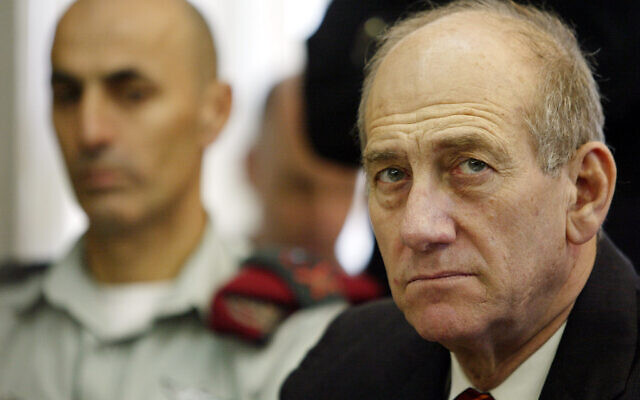
Then-prime minister Ehud Olmert pauses prior to a meeting of the Foreign Affairs and Defense committee at the Knesset in Jerusalem, October 30, 2006. (Pierre Terdjman / Flash90)
At this point, Sofrin described one of the most dramatic moments in Israel’s security history: the moment in which a prime minister received news of an existential threat to the country.
“Olmert sat, listened with great concentration and remained silent. After a few seconds he leaned back, exhaled and asked: ‘What do we do with this?’”
“I entered the room where Ehud Olmert and Dagan were sitting, and I said to the prime minister: ‘Do you remember our briefing on the Syrian nuclear issue? Well, Mr. Prime Minister, the question marks are removed, there are only exclamation marks.’
“Olmert sat, listened with great concentration and remained silent. After a few seconds he leaned back, exhaled and asked: ‘What do we do with this?’”
“Dagan and I answered automatically: ‘Take it down.’ From here everything started to unfold: the establishment of a special cabinet with expert teams and meticulous monitoring of the Air Force’s preparations.”
The race against time
At that point, Israel entered a race against time for fear that the plutonium shipment was already in Syria and the reactor would be switched on, Sofrin said. If that were the case, any attack on it would mean an uncontrolled nuclear explosion. Olmert appealed to the Americans, asking that they attack the site.
“George W. Bush refused and Olmert ended the conversation with the sentence, ‘Israel will do what it has to do.’”
Beyond the intelligence and operational effort, Israel’s strict working assumption was that following the reactor bombing Assad would start a war with Israel. In the preparatory talks with Bush, Israel asked for unique weapons in large quantities. The administration immediately assented and asked: “By plane or by ship?”
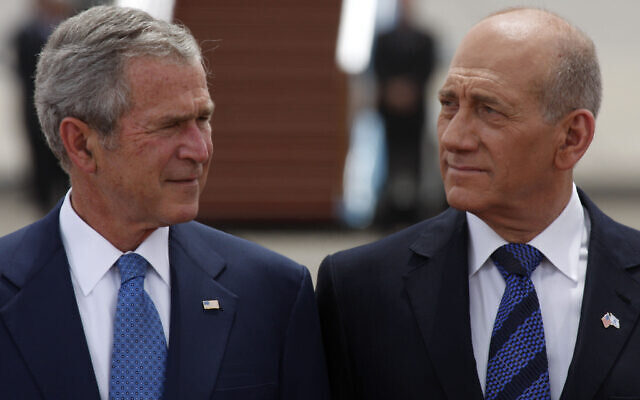
Then-prime minister Ehud Olmert, right, stands with then-US president George W Bush during a welcoming ceremony at Ben Gurion International Airport in Tel Aviv on May 14, 2008. (Nati Shohat/Flash90)
In Israel there was concern that air trains would reveal Israel’s intentions because Syria had already begun to show signs of suspicion. The decision was made to bring the armaments by sea, but when the American ship arrived, it turned out that it was too big to dock in Ashdod port.
The only suitable port was on the island of Crete. The ship was diverted there and for three days Israeli ships loaded the cargo in Crete and transported it to Israel without anyone noticing the intense Israeli activity in the Mediterranean Sea.
In what was dubbed Operation Outside the Box, the IDF on September 6, 2007, bombed the Syrian reactor, demolishing the site.
Strategic balance: A red light, a mistake
In retrospect, it became clear to Israel that as in the case of the Libyan nuclear project, everything had been done under the radar, out of sight of Israeli or American intelligence. North Korea, under the guise of aid to the missile industry, managed to trick the West once again. The Syrian reactor was an exact copy of the nuclear reactor in North Korea.
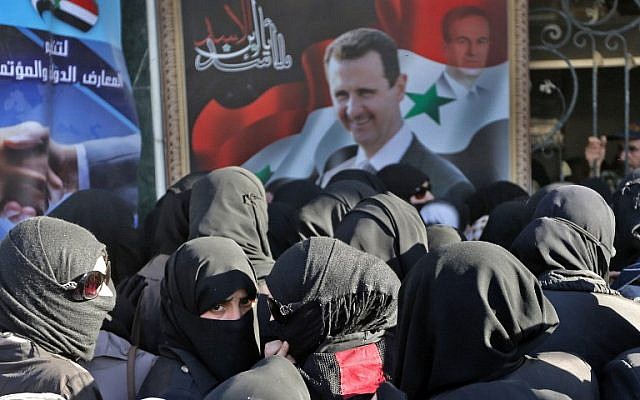
Syrian women walk past a large portrait of President Bashar al-Assad and a watermarked portrait of his late father and former President Hafez al-Assad as they queue to attend the government-sponsored “Ghouta Shopping Festival”, in the Eastern Ghouta town of Douma, on the eastern outskirts of the capital Damascus, on May 13, 2018.(AFP PHOTO / LOUAI BESHARA)
Finally, Sofrin provided a very interesting insight. The project did not begin with Bashar Assad but with his father, Hafez, probably already in the mid-1980s.
Assad the elder often mentioned the phrase “strategic balance” during this period. In Israel that was taken to mean one thing, but Assad meant something else.
“When Hafez Assad said ‘strategic balance’ we thought he was talking about a significant strengthening of his conventional military capacity to face Israel alone,” Sofrin said.
“Assad Jr. put out something similar and we thought he was echoing his father. Only in hindsight did we realize that he meant going nuclear. The thinking and planning were the father’s, for sure.”
The original Hebrew version of this article appears on The Times of Israel’s sister site, Zman Yisrael, here.



Comments are closed.